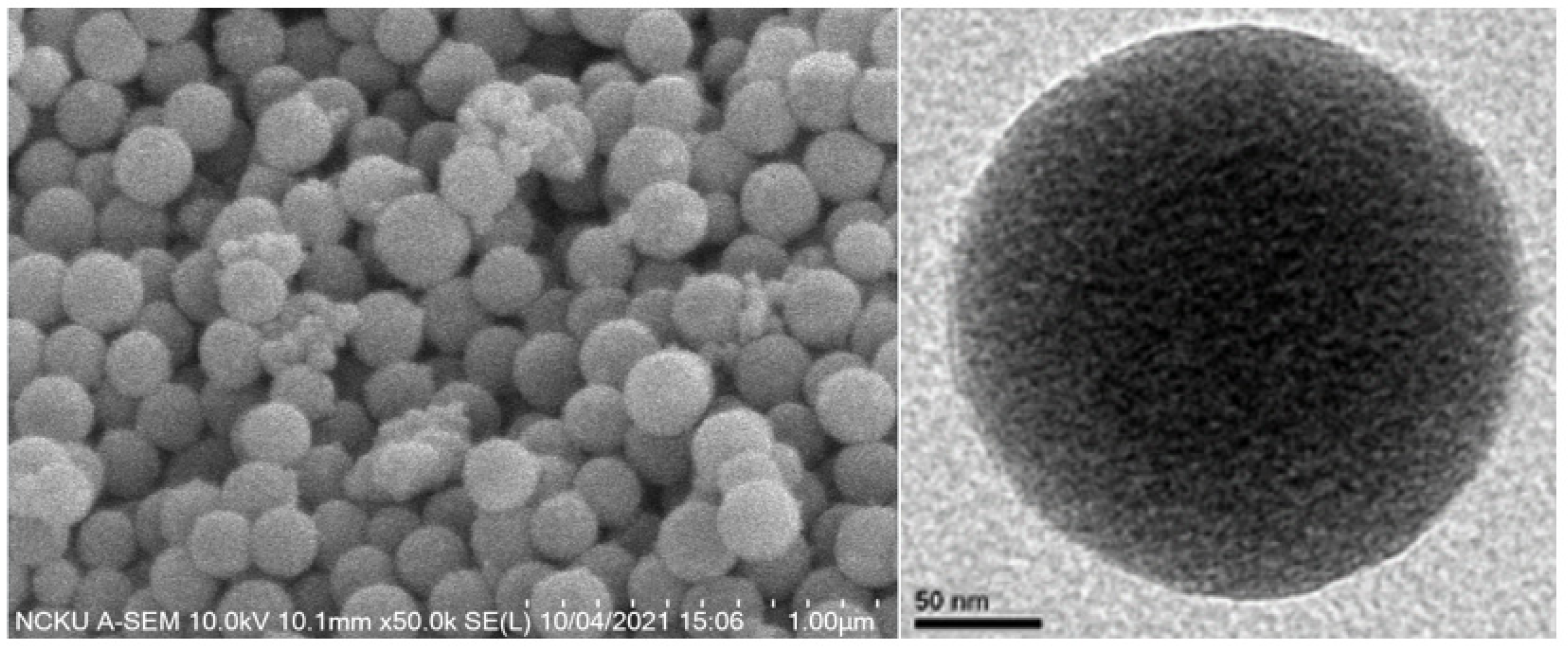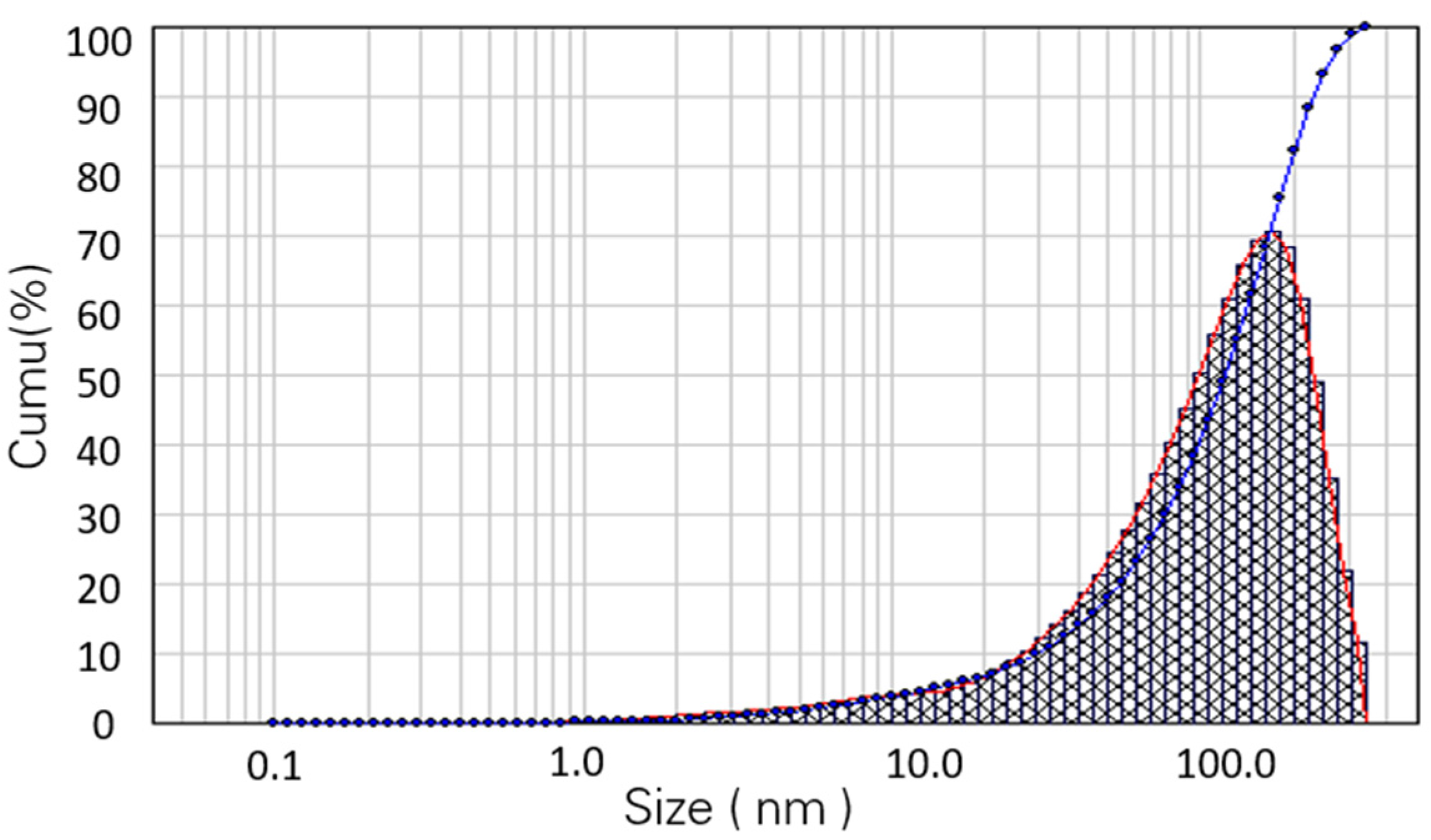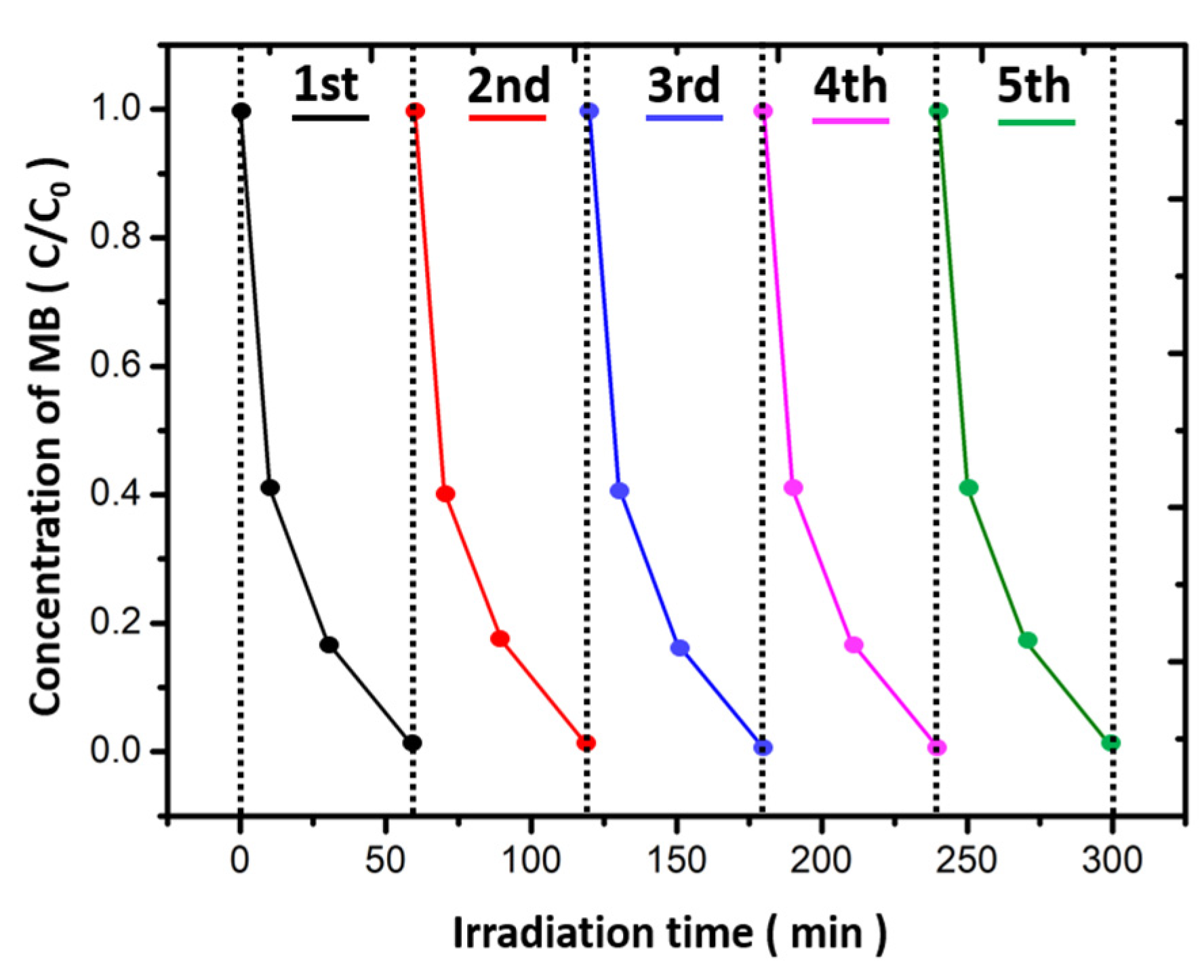The Photocatalytic Performance of Ag-Decorated SiO2 Nanoparticles (NPs) and Binding Ability between Ag NPs and Modifiers
Abstract
:1. Introduction
2. Materials and Methods
2.1. Reagents and Material
2.2. Characterization Methods
2.3. Preparation of SiO2 Nanoparticles (NPs)
2.4. Surface Modification of SiO2 NPs
2.5. Preparation of Ag-Coated Modification SiO2 NPs
2.6. Photocatalysis Analysis
3. Results and Discussion
3.1. Characterization of Nano-SiO2
3.2. Fourier Transform Infrared (FT-IR) Analysis
3.3. Surface Morphologies and Elemental Distribution
3.4. X-ray Photoelectron Spectroscopy (XPS) Analysis
3.5. Ultraviolet (UV)−Visible Absorption Spectra and Photocatalysis Analysis
4. Conclusions
Author Contributions
Funding
Institutional Review Board Statement
Informed Consent Statement
Data Availability Statement
Acknowledgments
Conflicts of Interest
References
- Li, Y.; Shao, L.; Zhong, F.; Ding, P.; Chu, B.; Luo, F.; Xu, K.; Zeng, F.; Du, Y. Light control based on unidirectional scattering in metal–dielectric core–shell nanoparticles. Opt. Commun. 2018, 426, 483–489. [Google Scholar] [CrossRef]
- Shafer-Peltier, K.E.; Haynes, C.L.; Glucksberg, M.R.; van Duyne, R.P. Toward a glucose biosensor based on surface-enhanced Raman scattering. J. Am. Chem. Soc. 2003, 125, 588–593. [Google Scholar] [CrossRef] [PubMed]
- Li, X.; Niitsoo, O.; Couzis, A. Electrostatically assisted fabrication of silver-dielectric core/shell nanoparticles thin film capacitor with uniform metal nanoparticle distribution and controlled spacing. J. Colloid Interface Sci. 2016, 465, 333–341. [Google Scholar] [CrossRef] [PubMed]
- Zhang, Y.-S.; Wang, M.; Yang, C.; Shao, Y.-W.; Qi, X.-D.; Yang, J.-H.; Wang, Y. Heterogeneous BaTiO3@Ag core-shell fibers as fillers for polymer dielectric composites with simultaneously improved dielectric constant and breakdown strength. Compos. Commun. 2021, 27, 100874. [Google Scholar] [CrossRef]
- Xu, G.; Zhu, X. A core-shell structured Zn/SiO2@ZSM-5 catalyst: Preparation and enhanced catalytic properties in methane co-aromatization with propane. Appl. Catal. B Environ. 2021, 293, 120241. [Google Scholar] [CrossRef]
- Zhang, C.; He, H. A comparative study of TiO2 supported noble metal catalysts for the oxidation of formaldehyde at room temperature. Catal. Today 2007, 126, 345–350. [Google Scholar] [CrossRef]
- Hirakawa, T.; Kamat, P.V. Charge separation and catalytic activity of Ag@TiO2 core-shell composite clusters under UV-irradiation. J. Am. Chem. Soc. 2005, 127, 3928–3934. [Google Scholar] [CrossRef]
- Yousefi, A.; Kashi, M.A.; Afghahi, S.S.S. Enhancement and recovery of magnetic exchange coupling properties in SrFe11AlO19@NiFe2O4 core-shell structure by multiple TiO2 and SiO2 nanolayer shells. J. Magn. Magn. Mater. 2021, 530, 167932. [Google Scholar] [CrossRef]
- Padovini, D.; Magdalena, A.; Capeli, R.; Longo, E.; Dalmaschio, C.; Chiquito, A.; Pontes, F. Synthesis and characterization of ZrO2@SiO2 core-shell nanostructure as nanocatalyst: Application for environmental remediation of rhodamine B dye aqueous solution. Mater. Chem. Phys. 2019, 233, 1–8. [Google Scholar] [CrossRef]
- Ferreira-Neto, E.P.; Ullah, S.; Simões, M.B.; Perissinotto, A.P.; de Vicente, F.S.; Noeske, P.-L.M.; Ribeiro, S.J.; Rodrigues-Filho, U.P. Solvent-controlled deposition of titania on silica spheres for the preparation of SiO2@TiO2 core@shell nanoparticles with enhanced photocatalytic activity. Colloids Surf. A Physicochem. Eng. Asp. 2019, 570, 293–305. [Google Scholar] [CrossRef]
- Kim, Y.H.; Jo, B.G.; Jeong, J.H.; Kang, Y.S. Preparation and Characterization of Cu-SiO2 Nanoparticles. Solid State Phenom. 2007, 121–123, 255–258. [Google Scholar] [CrossRef]
- Kim, J.-H.; Bryan, W.W.; Lee, T.R. Preparation, characterization, and optical properties of gold, silver, and gold-silver alloy nanoshells having silica cores. Langmuir 2008, 24, 11147–11152. [Google Scholar] [CrossRef] [PubMed]
- Zhu, M.; Qian, G.; Wang, Z.; Wang, M. Fabrication of nanoscaled silica layer on the surfaces of submicron SiO2-Ag core-shell spheres. Mater. Chem. Phys. 2006, 100, 333–336. [Google Scholar] [CrossRef]
- Park, S.-Y.; Han, K.; O’Neill, D.B.; Mul, G. Stability of Ag@SiO2 core–shell particles in conditions of photocatalytic overall water-splitting. J. Energy Chem. 2017, 26, 309–314. [Google Scholar] [CrossRef]
- Xu, K.; Wang, J.-X.; Kang, X.-L.; Chen, J.-F. Fabrication of antibacterial monodispersed Ag–SiO2 core–shell nanoparticles with high concentration. Mater. Lett. 2009, 63, 31–33. [Google Scholar] [CrossRef]
- Chen, X.-J.; Cabello, G.; Wu, D.-Y.; Tian, Z.-Q. Surface-enhanced Raman spectroscopy toward application in plasmonic photocatalysis on metal nanostructures. J. Photochem. Photobiol. C Photochem. Rev. 2014, 21, 54–80. [Google Scholar] [CrossRef]
- Pan, K.-Y.; Liang, Y.-F.; Pu, Y.-C.; Hsu, Y.-J.; Yeh, J.-W.; Shih, H.C. Studies on the photocatalysis of core-shelled SiO2–Ag nanospheres by controlled surface plasmon resonance under visible light. Appl. Surf. Sci. 2014, 311, 399–404. [Google Scholar] [CrossRef]
- Mouni, L.; Belkhiri, L.; Bollinger, J.-C.; Bouzaza, A.; Assadi, A.; Tiri, A.; Dahmoune, F.; Madani, K.; Remini, H. Removal of Methylene Blue from aqueous solutions by adsorption on Kaolin: Kinetic and equilibrium studies. Appl. Clay Sci. 2018, 153, 38–45. [Google Scholar] [CrossRef]
- Pang, J.; Fu, F.; Ding, Z.; Lu, J.; Li, N.; Tang, B. Adsorption behaviors of methylene blue from aqueous solution on mesoporous birnessite. J. Taiwan Inst. Chem. Eng. 2017, 77, 168–176. [Google Scholar] [CrossRef]
- Hou, C.; Hu, B.; Zhu, J. Photocatalytic Degradation of Methylene Blue over TiO2 Pretreated with Varying Concentrations of NaOH. Catalysts 2018, 8, 575. [Google Scholar] [CrossRef] [Green Version]
- Zhang, L.; Feng, Y.-G.; Wang, L.-Y.; Zhang, J.-Y.; Chen, M.; Qian, D.-J. Comparative studies between synthetic routes of SiO2@Au composite nanoparticles. Mater. Res. Bull. 2007, 42, 1457–1467. [Google Scholar] [CrossRef]
- Mondin, G.; Lohe, M.; Wisser, F.; Grothe, J.; Mohamed-Noriega, N.; Leifert, A.; Dörfler, S.; Bachmatiuk, A.; Rümmeli, M.H.; Kaskel, S. Electroless copper deposition on (3-mercaptopropyl) triethoxysilane-coated silica and alumina nanoparticles. Electrochim. Acta 2013, 114, 521–526. [Google Scholar] [CrossRef]
- Sakai, T.; Enomoto, H.; Sakai, H.; Abe, M. Direct Fabrication of Silica-Coated Gold Nanoparticles and Gold Nanoparticle-Deposited Silica Spheres in Aqueous Media. J. Jpn. Soc. Colour Mater. 2009, 82, 387–396. [Google Scholar] [CrossRef] [Green Version]
- Nedeljko, P.; Turel, M.; Košak, A.; Lobnik, A. Synthesis of hybrid thiol-functionalized SiO2 particles used for agmatine determination. J. Sol-Gel Sci. Technol. 2016, 79, 487–496. [Google Scholar] [CrossRef]
- Chen, J.E.; Wang, Q.; Shull, K.R.; Richards, J.J. Control over electroless plating of silver on silica nanoparticles with sodium citrate. J. Colloid Interface Sci. 2020, 576, 376–384. [Google Scholar] [CrossRef] [PubMed]
- Wang, X.-D.; Shen, Z.-X.; Sang, T.; Cheng, X.-B.; Li, M.-F.; Chen, L.-Y.; Wang, Z.-S. Preparation of spherical silica particles by Stober process with high concentration of tetra-ethyl-orthosilicate. J. Colloid Interface Sci. 2010, 341, 23–29. [Google Scholar] [CrossRef]
- Jin, Y.; Lohstreter, S.; Pierce, D.T.; Parisien, J.; Wu, M.; Hall, I.C.; Zhao, J.X. Silica nanoparticles with continuously tunable sizes: Synthesis and size effects on cellular contrast imaging. Chem. Mater. 2008, 20, 4411–4419. [Google Scholar] [CrossRef]
- Shimura, N.; Ogawa, M. Preparation of surfactant templated nanoporous silica spherical particles by the Stöber method. Effect of solvent composition on the particle size. J. Mater. Sci. 2007, 42, 5299–5306. [Google Scholar] [CrossRef]
- Jankiewicz, B.J.; Jamiola, D.; Choma, J.; Jaroniec, M. Silica-metal core-shell nanostructures. Adv. Colloid Interface Sci. 2012, 170, 28–47. [Google Scholar] [CrossRef]
- An, Y.; Chen, M.; Xue, Q.; Liu, W. Preparation and self-assembly of carboxylic acid-functionalized silica. J. Colloid Interface Sci. 2007, 311, 507–513. [Google Scholar] [CrossRef]
- Wang, H.; Zheng, L.; Liu, G.; Zhou, Y. Enhanced adsorption of Ag+ on triethanolamine modified titanate nanotubes. Colloids Surf. A Physicochem. Eng. Asp. 2018, 537, 28–35. [Google Scholar] [CrossRef]
- Chen, D.; Liu, H.-Y.; Liu, J.-S.; Ren, X.-L.; Meng, X.-W.; Wu, W.; Tang, F.-Q. A general method for synthesis continuous silver nanoshells on dielectric colloids. Thin Solid Films 2008, 516, 6371–6376. [Google Scholar] [CrossRef]
- Chen, K.-H.; Pu, Y.-C.; Chang, K.-D.; Liang, Y.-F.; Liu, C.-M.; Yeh, J.-W.; Shih, H.-C.; Hsu, Y.-J. Ag-nanoparticle-decorated SiO2 nanospheres exhibiting remarkable plasmon-mediated photocatalytic properties. J. Phys. Chem. C 2012, 116, 19039–19045. [Google Scholar] [CrossRef] [Green Version]
- Khedkar, C.V.; Daware, K.D.; Badgujar, P.S.; Kolekar, Y.D.; Gosavi, S.W.; Patil, S.I. Ag–SiO2 nanocomposite for the optical detection of Hg(II) ions and catalytic reduction of methylene blue. Opt. Mater. 2021, 120, 111426. [Google Scholar] [CrossRef]
- Chen, S.-L. Preparation of monosize silica spheres and their crystalline stack. Colloid Surf. A 1998, 142, 59–63. [Google Scholar] [CrossRef]
- Scherer, K.; Nouvelot, L.; Lacan, P.; Bosmans, R. Optical and mechanical characterization of evaporated SiO2 layers. Long-term evolution. Appl. Opt. 1996, 35, 5067–5072. [Google Scholar] [CrossRef] [PubMed]
- Gu, D.; Sistiabudi, R.; Dey, S.K. Modification of work function of Ti by self-assembled monolayer molecules on SiO2/p-Si. J. Appl. Phys. 2005, 97, 123710. [Google Scholar] [CrossRef]
- Ye, L.; Liang, C.; He, J.; Ou, J.; Wu, Q. Facile preparation of ordered macroporous carboxyl group functionalized polymer@SiO2 composites and their adsorption performance towards proteins. J. Inorg. Organomet. Polym. Mater. 2018, 28, 1011–1020. [Google Scholar] [CrossRef]
- Schaefers, S.; Rast, L.; Stanishevsky, A. Electroless silver plating on spin-coated silver nanoparticle seed layers. Mater. Lett. 2006, 60, 706–709. [Google Scholar] [CrossRef]
- Jackson, J.D.; Fox, R.F. Classical electrodynamics, 3rd ed. Am. J. Phys. 1999, 67, 841–842. [Google Scholar] [CrossRef]
- Jain, P.K.; El-Sayed, M.A. Noble metal nanoparticle pairs: Effect of medium for enhanced nanosensing. Nano Lett. 2008, 8, 4347–4352. [Google Scholar] [CrossRef] [PubMed]
- Sancho-Parramon, J. Surface plasmon resonance broadening of metallic particles in the quasi-static approximation: A numerical study of size confinement and interparticle interaction effects. Nanotechnology 2009, 20, 235706. [Google Scholar] [CrossRef] [PubMed]
- Yunarti, R.T.; Safitri, T.N.; Dimonti, L.C.C.; Aulia, G.; Khalil, M.; Ridwan, M. Facile synthesis of composite between titania nanoparticles with highly exposed (001) facet and coconut shell-derived graphene oxide for photodegradation of methylene blue. J. Phys. Chem. Solids 2021, 160, 110357. [Google Scholar] [CrossRef]
- Ge, Y.; Luo, H.; Huang, J.; Zhang, Z. Visible-light-active TiO2 photocatalyst for efficient photodegradation of organic dyes. Opt. Mater. 2021, 115, 111058. [Google Scholar] [CrossRef]
- Sun, Y.; Cai, L.; Liu, X.; Cui, Z.; Rao, P. Tailoring heterostructures of Ag/Cu2O hybrids for enhanced photocatalytic degradationdegradation. J. Phys. Chem. Solids 2017, 111, 75–81. [Google Scholar] [CrossRef]
- Li, S.; Lin, Q.; Liu, X.; Yang, L.; Ding, J.; Dong, F.; Li, Y.; Irfan, M.; Zhang, P. Fast photocatalytic degradation of dyes using low-power laser-fabricated Cu2O–Cu nanocomposites. RSC Adv. 2018, 8, 20277–20286. [Google Scholar] [CrossRef] [Green Version]
- Yao, X.; Liu, X. One-pot synthesis of Ag/AgCl@SiO2 core–shell plasmonic photocatalyst in natural geothermal water for efficient photocatalysis under visible light. J. Mol. Catal. A Chem. 2014, 393, 30–38. [Google Scholar] [CrossRef]









| D10 | D50 | D90 |
|---|---|---|
| 34.7 nm | 125.2 nm | 234.6 nm |
| Nano-SiO2 | Si | Al | Mg |
|---|---|---|---|
| ppm | 76.224 | 0.62 | 0.15 |
| Wt % | 98.87 | 0.81 | 0.191 |
| Si 2p | O 1s | Ag 3d5 | |
|---|---|---|---|
| -NH2 | 64.3 | 26.4 | 9.3 |
| -SH | 67.4 | 24.3 | 8.3 |
| -OH− | 63.1 | 25.1 | 11.8 |
| -COOH | 66.5 | 25.8 | 7.7 |
| Catalyst | Additive Amount (mg) | Concentration of MB (M) | % Degradation | Irradiation Time (min) | Ref. |
|---|---|---|---|---|---|
| TiO2(001)/GO | 40 | 1 × 10−2 | 51.3 | 60 | [43] |
| Active-TiO2 | 21 | 3.125 × 10−2 | >95 | 60 | [44] |
| Au/Cu2O | 20 | 3.125 × 10−2 | 96.5 | 120 | [45] |
| Cu2O-Cu | 9 | 3.125 × 10−2 | 90 | 50 | [46] |
| Ag/AgCl@SiO2 | 7 | 3.125 × 10−2 | >99 | 15 | [47] |
| SiO2/Ag (Sn+) | 0.5 | 2 × 10−5 | >95 | 60 | [17] |
| Ag-OH−-SiO2 | 5 | 1 × 10−3 | >99 | 60 | Present study |
| Ag-NH2-SiO2 | 5 | 1 × 10−3 | 82 | 60 | Present study |
Publisher’s Note: MDPI stays neutral with regard to jurisdictional claims in published maps and institutional affiliations. |
© 2022 by the authors. Licensee MDPI, Basel, Switzerland. This article is an open access article distributed under the terms and conditions of the Creative Commons Attribution (CC BY) license (https://creativecommons.org/licenses/by/4.0/).
Share and Cite
Chen, W.-S.; Chen, H.-R.; Lee, C.-H. The Photocatalytic Performance of Ag-Decorated SiO2 Nanoparticles (NPs) and Binding Ability between Ag NPs and Modifiers. Coatings 2022, 12, 146. https://doi.org/10.3390/coatings12020146
Chen W-S, Chen H-R, Lee C-H. The Photocatalytic Performance of Ag-Decorated SiO2 Nanoparticles (NPs) and Binding Ability between Ag NPs and Modifiers. Coatings. 2022; 12(2):146. https://doi.org/10.3390/coatings12020146
Chicago/Turabian StyleChen, Wei-Sheng, Hong-Ren Chen, and Cheng-Han Lee. 2022. "The Photocatalytic Performance of Ag-Decorated SiO2 Nanoparticles (NPs) and Binding Ability between Ag NPs and Modifiers" Coatings 12, no. 2: 146. https://doi.org/10.3390/coatings12020146






